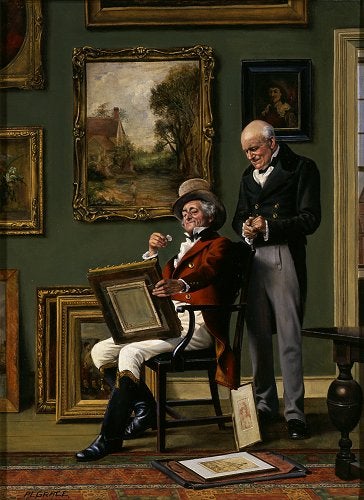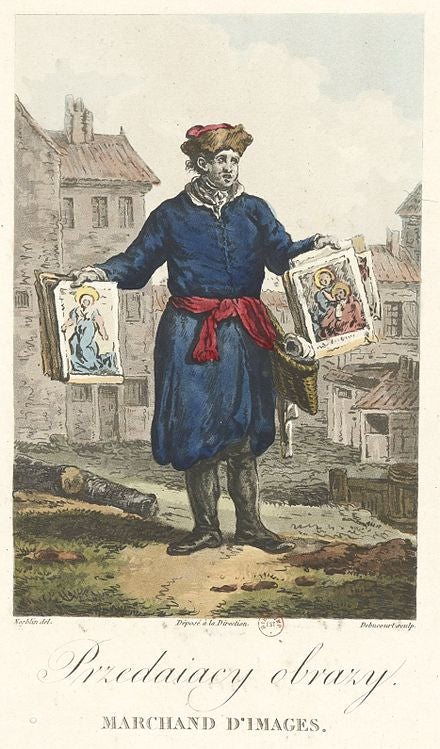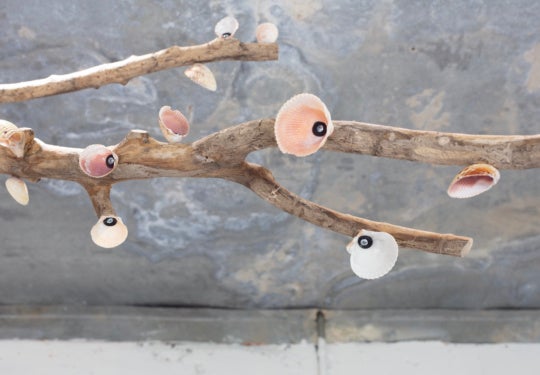
This month’s “Charmed, I’m Sure” is brought to you by Digital Arts Studio. For over 10 years, Digital Arts Studio has helped artists increase profits by providing museum-quality reproductions of their original artwork. Learn more about Digital Arts Studio here.
What does it actually mean to be represented in a commercial gallery? There may expectations between artist and dealer that are unspoken but assumed on both ends. I asked Lloyd Benjamin of Get This! and Robin Bernat of Poem 88, both in Atlanta, Steve Williams of Florida Mining in Jacksonville, FL, and Lain York of Zeitgeist Gallery in Nashville to answer these eight questions to shed some light on best professional practices of a represented artist.
What do you expect from the artists you show?
Lloyd Benjamin: I expect a lot of things. The usual stuff. Professionalism, a good attitude, an openness to outside ideas and critique. But I think those things are a two way street. I also expect from them that they will approach their show with total confidence and that they bring to the table excellent work that impresses and sells.
Robin Bernat: When I am working with an artist, that relationship is a partnership. We both bring something to the table. And, it’s not simply that they are providing the work and I am providing the space. We are entering a business partnership to move their career and their work forward. Also, it’s a collaborative process: the artists have ideas about what they want to produce and I have to gauge the feasibility for the gallery and the space and see what I can do to make those things happen. I also have to think about the work within the space of the gallery and consider who is the audience for the work.
I sometimes want to see that the artist is really reaching for a new level of expression … and they are willing to take risks. If the artist seems stuck, I will absolutely say so. Sometimes it happens that the artist has a more limited view of what might happen within the context of their show. It’s my job to help them consider other possibilities (ones that are achievable). I expect them to produce excellent work! If we are working on an upcoming show, I expect them to meet deadlines for getting images to me, delivering the work, and I also expect them to participate in promoting the show.
Steve Williams: We want the artists we show to provide consistent work and enough of it to sell. If we have a project, we ask that the artist provide us with high quality images, specifications, and anything we need to know about the body of work that we are proposing. As far as an overall rule of representation, we do not have a standard for that and take each artist separately, depending on what they are trying to accomplish, what we see as opportunities, and where we see the relationship going.
Lain York: It’s very much a collaborative relationship and we look for artists with active networks. In the current art world, the relationship between galleries and artists is one of resource sharing.
How do you go about finding new artists for your gallery? Do you approach them, or do they approach you?
Benjamin: Lots of different ways. I like to say that I structure my gallery’s program as a response to the way I live my life and the interactions and events that leave an impression on me. The way I select artists is very personal. I have never worked with an artist who sent a formal submission to my gallery; that’s why I do not accept artist submissions any longer.
Bernat: Either I’ve known the artists for a long while—perhaps went to school with them or exhibited with them—or I’ve seen their work elsewhere and feel that they are a good match for the gallery. It is very rare that an artist contacts me and it’s a fit.
Williams: We have 20-year relationships with some of our artists and have followed their careers as they have grown. For new artists, it is more of a mix. Some we find organically as we look around, and some find us and apply to work with us.
York: Both. What makes a gallery distinctive is “the conversation” the associated artists bring, and those associations come from collectors, artists, and curators. Zeitgeist has traditionally focused on Nashville-based artists and those with ties to the area, but increasingly we are looking outside to put their work in the context of what’s happening internationally. Many of our associations began through local artist-run spaces and the network they provide. I will add that we really like the artists we work with as individuals.
How do you reach agreements with the artists you represent about showing and selling work? Do you use the honor system, or do you find contracts are more successful?
Benjamin: A hand shake. I do not do contracts, although I’m not opposed to the idea. I’m sure contracts are coming soon for me, but it’ll be a case-by-case situation. In my eyes, it’s not hard to do the right thing. People know when they’re messing up.
Bernat: I have a general contract with information about delivery and return of work, providing images for promotional purposes, the split on sales, etc. My contract does not have an exclusivity clause, but I have expectations from my artists about adhering to it locally. In the case that an artist participates in a large group show elsewhere, I would like the gallery to be appropriately credited and given a small percentage of sales.
Williams: We have been more successful with the honor system. We typically work on a consignment contract. The exclusivity contracts and more binding and regulated situations seem to cause trouble. Either the gallery isn’t getting what it needs or the artist doesn’t feel represented at his/her level of expectation and the contract often doesn’t specify enough for each party.
York: We have looked at contracts but the wording was always too complicated. The honor system works for us as we see the artists as professionals, and we assume they treat us similarly. The gallery operates with a standard consignment agreement that we amend as needs arise. About every clause in the agreement benefits and protects the artist and the work.
Do you ever ask an artist to make a certain kind of work for a show, or do you allow them to produce as they see fit?
Benjamin: Yes to both. It’s a mutual thing. I usually ask an artist to do a show of work that I like. I expect that work to be the show I get. But I also realize that sometimes things evolve and change from the time a show is committed to and when the work is made. I have more influence on the final work in some shows than others. Some artists work up to the last minute and it’s kind of like a “well, this is what you get” situation, which I do not like. I enjoy the editing process leading up to an exhibition. Options are good.

Bernat: I do not ask that an artist make a particular kind of work but I may make suggestions. I view exhibitions as a collaboration between the gallery and the artist, and I may steer them toward something they might not have considered. I prefer that there is steady communication about the progress of the work and if something arises that I see as problematic, then I discuss it with them. Sometimes I may ask artists to work around a theme, like the one for the “Blow Up” show.
Williams: In the past we have done both. We believe that to encourage and give feedback to the artist works the best. Sometimes asking an artist to work on a certain theme spins them out. Often times, if we have a show that is thematic, we will more often than not curate from existing works.
York: We think we have always been a very artist-friendly space and have never thought that giving too much direction to be helpful. Like most galleries, we lend experience (20 years) and a sense of objectivity when laying out shows, and we do quite a bit of editing when it comes to final presentation. Artists are invited to show on the strength of their work, are given specific dates for media/invitation images, deadlines for press releases, dates for delivery and receptions, and we expect them to follow through. They do because they are professionals, and we are always available to help at any point along the way. I think we have consistently provided a platform for artists to stretch out and take chances.
Do you actively connect artists with other cities or is that more of a requirement of the artist?
Benjamin: I do. I think artists should always look outside of their immediate communities, reach out to other cities, build relationships in other towns with dealers, artists, folks at institutions. It’s very important. I feel the same way about how I handle my gallery.
Bernat: At this moment, I am not actively connecting artists with other galleries, but I do send their work to curators outside of Atlanta.
Williams: We try and help our artists grow. We work on making relationships on all levels, so we have done both. We have taken artists to other galleries where they were more successful than with us and fully supported that. We have also kept certain artists in our area, as they sell well in this region. And we work on projects all over, so we do not expect this market to sustain our sales. We work to achieve a high level of communication and ethics with the artists and the clients as well as other galleries. At the end of the day, it is about sales and margins, so sometimes it just doesn’t fiscally make sense to work with a consultant or another gallery. And sometimes, the situation is good, and it makes sense to do that.
York: I think the studio community is a much more effective tool than it realizes. Commercial galleries rely on artists to actively network, and this independent activity draws interest from a collector base. This may not be the engine that has most recently driven the art market, but this is the conversation I’m interested in. We all see a richer conversation when such industry players as commercial galleries, academic programs, museums, state and city art commissions foster these connections, but I believe it is the job of individual artists to generate excitement and resources within studio communities.
When another gallery wants to show your artists work in the same city or state, what are your policies? What are your policies out of state?
Benjamin: Generally, I’m not in support of that. I understand that artists will sometimes be asked to be in other shows. We just talk about it and deal with it case by case. Group shows are a different situation for me than solo shows in other commercial spaces. Institutions are, of course, a different situation. I do not allow my artists to do solo shows within the Atlanta area with any other commercial spaces, for several reasons. But if I’m doing my job right, why would they need to? Out of state is a different story. At the moment, I don’t have any established relationships with artists that I dictate or feel I have a say in their showings/business outside of the state. But that might change with a couple of the artists I work with, at least in managing a regional representation. Even then, I’m fine with the artist working with an out-of-state gallery; it would just need to involve my gallery.
Williams: We do not have a set policy. We do not really have a tight contract. Again the situation governs the decision. If it is local, we would support the artist to do what he/she desires. For us, it is always weird locally. We strive to work with artists who are unexpected and not showing on every corner, so we do not run into this often. If we do, we just try to come up with a fair deal for the gallery and artist. Sometimes this has led to split relationships and sometimes it ends well with everyone supporting each other, the preferred result, of course.
York: A lot of common sense is required here (particularly in regard to other local commercial galleries and independent curators), but we are all for it. I believe there is a protocol for such things, and it’s always nice to have a conversation with the gallery first. Gallery splits and credits are easily worked out. We have always felt it important to work with independent studio initiatives because this is where artists come from. Most recently here in Nashville, art dealers across the board have begun presenting work to shared clients in and out of town. The current economy demands it.
The art world is a very social environment. Where is the line between a friendship and business relationship with your artists?
Benjamin: I’m friends with all of my artists. I think that’s important. But when it’s time to talk business, it’s all business. You’ve got to be able to put aside your personal feelings and talk straight up.
Bernat: Generally speaking, I have a good friendship/relationship with each of the artists I represent. In some cases, they are very close friends of mine and we’ve known each other for a long while. I think that is the best situation; I know I can count on their high level of professionalism and there is mutual respect for one another. It is always best when each party involved can see the bigger picture. It’s not simply about sales; it’s about helping that artist move forward in their career, and helping them realize projects, providing opportunities and potentially new patronage. It’s a very complex situation and cordiality and professional courtesy are the minimum requirements.
Williams: This is a very tough line. As you learn about the artist, his/her life, and all of the things that make up the body of work, it is hard to draw a line. We choose to work with mature artists, such as Ke Francis, Marcus Kenney, Kedgar Volta and others, and part of the deciding factor is how easy they are to work with. If the relationship becomes difficult and emotional, it is never a good fit for us.
York: Hard to say exactly where that line is. Again, we treat our associates as professionals and we really like the artists we are fortunate enough to work with. Like any long-term relationship, there are ups and downs, but if the relationship (professional or otherwise) is worth maintaining, solutions are found. It’s a tough but invaluable lesson that one learns early on in any creative industry.
What do you think the benefit is for an artist to be represented in a gallery?
Benjamin: There are a ton of benefits. I think when an artist gets to a certain level, they should just understand, almost naturally, what those reasons are. I think it’s easy to understand once you are in it, the need for representation, that is. There’s a reason there is such a history of relationships between dealers and artists. A lot of artists are starting to question these relationships and their necessity because of social media and the “ease” of self promoting, and it may work for you for a minute, but there will be a time when you’ll want someone working on your behalf.
Bernat: The simplest answer to that question is: two heads are better than one.
Williams: This is hard to answer as each situation is different. If the artist negotiates being “represented,” which would include marketing, is that local? Regional? National? Each situation just depends on the deal. Each deal is different. What can the artist bring to the gallery, and what can the gallery do for the artist? I think it is important to think about our gallery systems locally, regionally, and nationally. What are the parameters of the representation? Several times we have found an artist work sold faster than he/she could make it. This is always good of course, ahem. But it was largely a combination of good work and an aggressive gallery willing to get out and hustle to make things happen. Good partnerships are what we are looking for.
York: Galleries are brick-and-mortar rallying points with developed networks of collectors/patrons, artists, patrons, media contacts, etc. Gallery-associated artists are definitely benefitting from exhibitions, inventory maintenance, and the work that goes into presentations to private, corporate, and public collections; initial meetings, digital presentations, site visits, installation, catalogue assistance and maintenance. Of course, then there are the runaway trains that are the art fairs. There are strong opinions across the board about these industry-generated entities, but love them or hate them, artists are dependent on galleries/dealers to take their work to them.
Gallery representation along with artist-run initiatives, academia, the museum system, etc., are hot-button topics because the industry in general is in major transition. We can look at this as the usual industry cycle or entirely new territory. Regardless, the studio community benefits from these outlets presenting their work. We feel that we do our part, and that any fine-art-industry support mechanism exists because of independent, studio artists. We feel that galleries offer support, opportunity, and a critical eye for the artist to grow, develop, and achieve goals they set for themselves.

This month’s “Charmed, I’m Sure” is brought to you by Digital Arts Studio. For over 10 years, Digital Arts Studio has helped artists increase profits by providing museum-quality reproductions of their original artwork. Their state of the art scanning & printing equipment, one-on-one customer service and marketing assistance has helped artists attain their goal of reaching greater sales. Learn more about Digital Arts Studio here.




